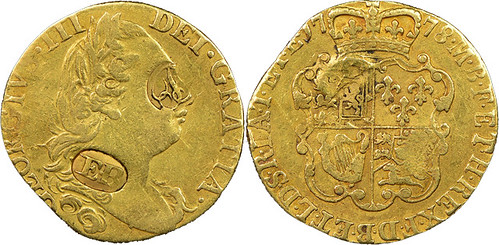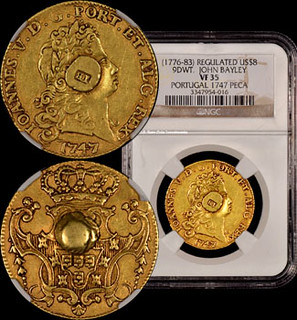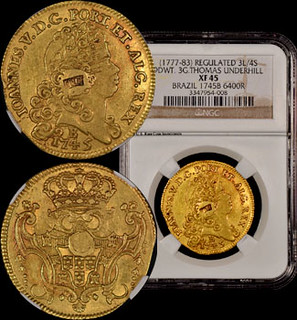
PREV ARTICLE
NEXT ARTICLE
FULL ISSUE
PREV FULL ISSUE
AMERICAN REGULATED GOLD PIECES
Numismatic News published a short article on February 29, 2016 about a group of American regulated gold pieces recently submitted
to Numismatic Guaranty Corporation. -Editor

The Numismatic Guaranty Corporation reports it certified six rare early American regulated gold pieces that were submitted during the New York International Numismatic Convention. Regulated gold coins represent an important era in United States coin circulation history. Before the U.S. began minting coins, foreign coins were used in commerce. In order to facilitate their circulation, the coins were clipped or had a plug added, regulating them to a specific weight. They were then stamped with a dollar value and the hallmark of the assayer. Five of the submitted coins bear the hallmark of Ephraim Brasher, a famous gold and silversmith. He is well known for producing the Brasher doubloon, the first gold coin minted for the United States. Joseph Richardson, Jr. stamped the other regulated gold piece. NGC states the dealer who sent the coins in noticed the interesting countermarks and was unaware of their rarity. To read the complete article, see:
A web search found a nice group of regulated gold at the site of Tom Pilitowski, US Rare Coin Investments. The coins pictured are in NGC
holders, but these may not be the pieces discussed in the Numismatic News article. Here's an excerpt, but be sure to read the
entire page; there's more information here on issuers of regulated gold than I remember seeing anywhere else. -Editor
 
Regulated Gold Coins - Article I, Section 8, Clause 5 of the Constitution gives Congress the power to “coin money, regulate the value thereof, and of foreign coin, and fix the standard of weights and measures.” This power was necessary in post-Revolutionary times because gold coins from many countries of the world circulated as legal tender in the United States. They were valued for their gold content not as specie. This cacophony of coins of the world would be an obvious source of confusion in domestic and foreign commerce. Coins from Brazil, Portugal, Spain, France, and England all circulated concurrently. However, each had a different weight and fineness making trade extremely inconvenient. The problem was first dealt with in colonial times, when coins were “regulated.” This practice continued after Independence. A goldsmith or silversmith would drill a coin and add gold in the form of a plug to increase its weight. If it was then overweight, he would clip and/or file its edge. Thus, coins were “regulated” to certain standards. The plugs that were added were then stamped with a hallmark identifying the regulator who guaranteed the gold content of the piece. Regulators, who were also jewelers and highly thought of members of the community, included John Bayley, John Burger, John David Jr., Lewis Feuter, Myer Myers, Thomas Pons, Thomas Underhill, and William Hollingshead. However, none was so prominent and famous in numismatic circles as Ephraim Brasher. When a gold coin circulates, its weight can change. Honest wear as well as dishonest practices cause changes in weight and therefore value. Coins were clipped and sometimes a bag of coins was “sweated.” It would be shaken and the resulting dust and other gold residue would be accumulated and later sold. So in addition to coins coming from different countries, they might have had to be regulated because of their diminished value as a result of wear, clipping, or sweating. Regulated coins have been found in collections of famous collectors and numismatists. These include Virgil M. Brand, Louis Eliasberg, John J. Ford Jr., John Work Garrett, Waldo Newcomer, and John L. Roper. Edward Roehrs had an excellent collection of regulated coins that was auctioned in 2010 at the ANA Boston World’s Fair of Money. For more information, see:

Wayne Homren, Editor The Numismatic Bibliomania Society is a non-profit organization promoting numismatic literature. See our web site at coinbooks.org. To submit items for publication in The E-Sylum, write to the Editor at this address: whomren@gmail.com To subscribe go to: https://my.binhost.com/lists/listinfo/esylum All Rights Reserved. NBS Home Page Contact the NBS webmaster 
|